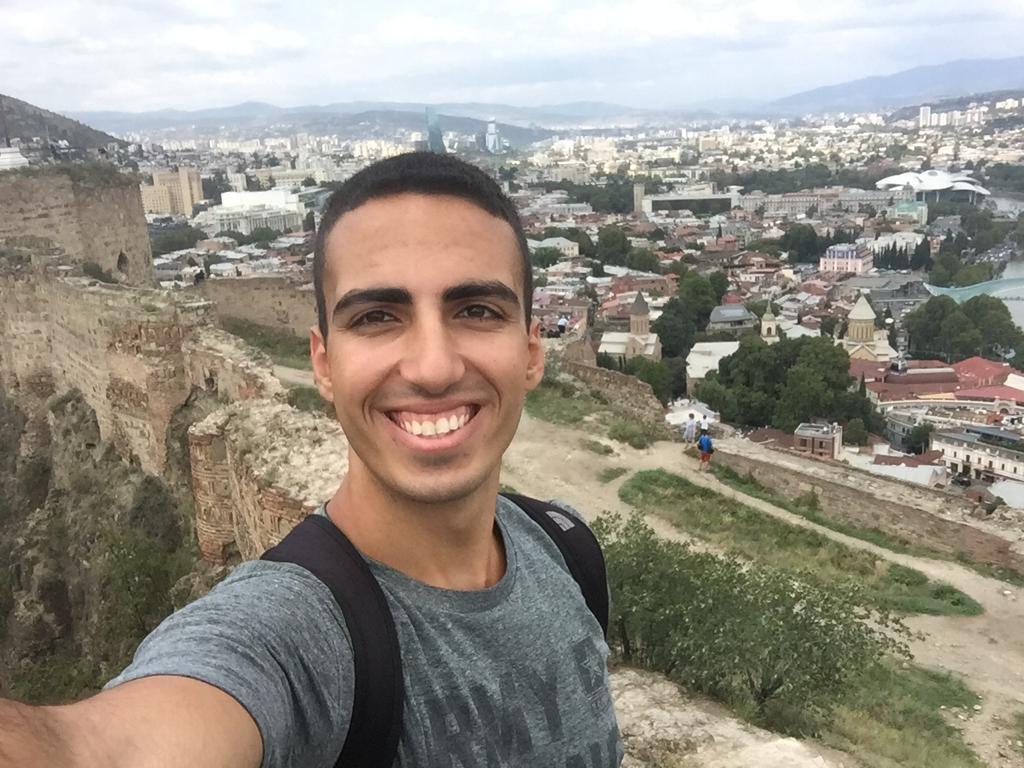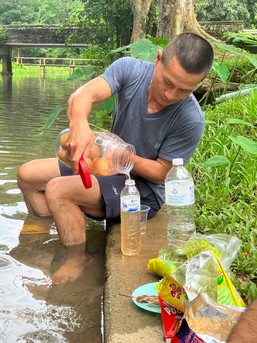A Wild Ride Along Thailand's Eastern Rim
- Aaron Schorr

- Jun 9, 2022
- 7 min read
Chonkeo, yok, AAHHH
After a night of barricading ourselves in our room from the monstrous moths that congregated outside our windows, we woke up to a breathtaking view of the valley and clouds forming right above us. A brief ride brought us to Phu Chi Fa, the tallest mountain in the area. We climbed up a muddy slope with cows to a view point, which would have been utterly stunning if not for the thick clouds that had formed below us. There was only a brief moment when the clouds parted enough to get a glimpse of the Laotian jungle and villages below, but the ridge we were on was blocking the clouds from blowing west. Since the border was drawn at the ridge, we got to technically cross into Laos again at the peak, and got featured on a Thai woman’s TikTok video.
We turned off the ridge road to follow an absurdly steep path through a village. With my engine screaming in second gear, I genuinely wondered how the Thai villagers descended these mountains on their automatic scooters, and then remembered Thailand’s road fatality statistics (more on that later). We could instantly feel it heat up as we descended into the valley, and the road became intermittently paved and potholed. The main road was possibly even worse, with an endless procession of dusty trucks passing over rutted construction sites until we arrived.
We were thrilled to arrive in a beautiful modern café in the outskirts of the town of Chiang Kaem. With jazz in the background, big picture windows, and three kinds of matcha for sale by the bag, this place could have been in any gentrified neighborhood in America, fitting right into the strangest phenomenon of lovely cafés surrounded by shacks and construction sites in Thai towns. It also fit right into the pattern of Thai restaurants being chronically understaffed, to the point where you could probably sit for an hour without getting service if you didn't get up to look for someone.
The midday heat was absolutely crushing when we stepped outside, with a heat index of 45º under blue skies. We checked into a nearby hotel and took a brief nap, and then set out for a nearby waterfall to cool down further. I tried buying some beers at a convenience store, but was informed that alcohol sales were inexplicably restricted to the hours of 11-2:00 and 5:00-midnight. We later learned that this was an attempt by the government to boost workforce participation, which makes the choice of hours very odd. The waterfall was almost deserted, save for two young men who invited us to sit with them. They turned out to be off-duty soldiers, who offered us green pea snacks, grilled chicken, and a mystery liquid in a water bottle they called “Lanna whiskey”. After a few sips, one of the guys disappeared only to return with a 2-liter jug of the stuff, and we could see that there were what looked like plums floating around in it.
The first guy poured us more brandy and taught us the Lanna way to toast: chonkeo, yok, clink glasses, and then you take a sip and exhale as loudly as possible. He repeated this ritual every time he took a sip, which was rather often. Having to ride back to the hotel, we stopped him from pouring us more after a while, to which he responded by typing something Google Translate told us meant “drunk sleeps here”. The other guy then asked us if marijuana was legal in our countries, and showed us photos of the plants he was growing in a tire on his base. It was good to see that some things are universal across militaries.
We had seen signs for a Thai-Lao border market several kilometers further down the road, but when we got there it was just an empty plaza overgrown with weeds with a border permit office to one side. Opposite was an unlocked abandoned building full of what looked like rotting bunk bed frames, which mostly fit the image of the ghost town. We were hearing lots of highly ominous thunder by this point, but we managed to get back dry.
Our dinner prospects were looking questionable, but the map showed a place just a few hundred meters down the main road. Said road was a pitch-black construction site, so we trudged over mud and rebar lit by periodic flashes of lightning in the distance. There was nobody else in the restaurant, but we got a large and delicious meal for 160 baht ($4.8).
The Temple of Anteaks
On our way out of town, we stopped at Wat Nantaram, a sprawling temple built entirely out of teak. The front area was the standard platform full of idols with space for monks, but things got weird further inside. We crossed a beautiful little courtyard and ended up in a maze of rooms full of seemingly random objects hoarded by someone’s grandmother. There were lamps, gongs, coins, and even fossilized animals. One room had old manuscripts in Burmese; another was dedicated to typewriters, and the wall leading back to the main part of the temple was lined with old televisions.
We were trying to make it back to Chiang Mai in one day, and stopped to break up the 260 km ride in the city of Phayao. The downtown has a lakefront with a massive plaza facing a monument dedicated to a Lanna king. People were laying flowers on monument, and the whole thing would have been lovely except for the severe lack of shade. I found the highlighting of Lanna history here and other places surprising, since it was implicitly anti-monarchy but clearly tolerated. To cool down, we got ice cream sundaes that included blue sticky rice, sliced coconut, and what I think was translucent mochi. This was far better than the other option on the menu, which was an ice cream “sandwich” with a literal folded slice of white bread.
Leaving Phayao, we encountered an intense thunderstorm but ducked under a very opportune (and rare) highway underpass for the 10 minutes it lasted. The thunderstorms here are so localized that it was literally pouring on one side of the underpass for 2 minutes longer than the other. We then tried to stop at a waterfall, but found it closed off with barbed wire. A small path led around the fence, but there were signs proclaiming that all national parks would close starting March 25 [2020] to “reduce the spread of COVID-19.” Twenty-six months later, the park was a post-apocalyptic relic, with gazebos overgrown with weeds and barely-discernible paths leading up to the waterfall.
After a lunch break at another Western-style restaurant literally in the middle of some rice paddies, we got on the first motorway we’d seen and sped south-west. Like most Asian motorcycles, our gears were absurdly low, and after an hour of intense vibrations at 90 km/h I could hardly feel half my body. We entered Chiang Mai in thick rush hour traffic, where we sat at several of the world’s longest traffic lights. Immediately after we arrived at our hostel, the heavens opened up and deposited what seemed like inches of water on the city. I could scarcely believe our luck, which had held up unbelievably well over the eight days and 1,200 kilometers of riding we had done.
Following the best shower I’d had since winter break, we had dinner with Osvaldo, a car salesman living in San Diego. The hostel was organizing a trip to a show, but both Richard and Osvaldo decided to sit it out. Instead, I piled into the back of a pickup truck with a dozen other tourists and ended up at a drag bar. The show was unbelievably entertaining, with a cast of ladyboys and male dancers performing lip synced routines to It’s Raining Men, Diamonds Are Forever, and K-pop hits. Some numbers were definitely better than others, and some would have been hugely controversial in the US. One number was Chinese-themed with a dragon and golden-red dresses (the Chinese in the crowd loved it), and another was a Whitney Houston song for which the performer put on light blackface and an afro wig.
After the show, the performers spent a lot of time taking photos with the crowd as a DJ who looked about 14 played EDM. One man in the front had been handing out a lot of cash during the show, and he received plenty of attention from the crew later. He vaguely looked like an Asian Elon Musk, and everything about him screamed “Chinese millionaire”, from the comb-over blond haircut, to the perpetual lit cigarette in his hand, to the matching t-shirt and shorts with Yankees logos made out of rhinestones. He bought the entire place a round of beers, and was very excited when we toasted him in Chinese. The clock struck midnight on June 1st. Happy Pride Month!
The Headache Express to Bangkok
We decided to take it relatively easy the next day after six uninterrupted days of riding. Wat Chedi Luang, the beautiful brick temple in the middle of the city, was in full festivity mode, apparently celebrating the anniversary of the city’s founding. In Thailand, a religious festival – along with most anything else – is an excuse for breaking out hundreds of food carts selling anything from soup to sweets. The people that were not busy eating were circulating around tables lined with pots and dropping coins in each or laying flower offerings on almost every available surface, coating the altars multiple feet deep at points.
In the afternoon, I decided to finally get a haircut and was pleasantly surprised by the results. One random observation I now have after getting my hair cut in at least a dozen countries is that the only women who have cut my hair have been East Asian, including in Chiang Mai. Less to my liking was the price discrimination: the sign in Thai said the price was 100 baht, while the English sign said 150. Before leaving, we had a delicious dinner of beef curry and mango lassi at a Pakistani restaurant outside the old town. The place had a big sign in Chinese proclaiming the friendship between the Pakistani and Chinese people, and the owner told us that there are about 100,000 Pakistanis living in Thailand, mostly in Bangkok and Chiang Mai.
Our flight to Bangkok was on the Thai subsidiary of VietJetAir, the atrocious Vietnamese airline that had flown me from Hanoi to Tokyo 2.5 years ago. The Thai version is no better, and it seems like the airline goes out of its way to make the service as unpleasant as possible. Your ticket and passport get checked no fewer than five times before a flight attendant personally shows you to your row, as if the numbers aren’t sequential. Then there’s the music. Before departure, they play something that sounds like J-pop with the chorus “happy happy happy”, but the real treat is on arrival. We took about 20 minutes to taxi at BKK, but the playlist only included one 3-minute Thai song. The song ends with an unbelievably shrill crescendo of “PLEASE ENJOY THE FLIIIIIIIGHT”, which was rather difficult to do under the circumstances.























































Comments